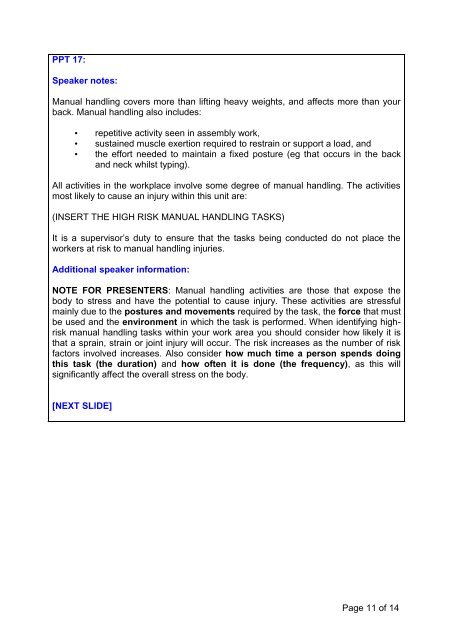Work Health & Safety Awareness Lesson Plan
Work Health & Safety Awareness Lesson Plan Work Health & Safety Awareness Lesson Plan
noticeboard); and• Follow all further directions from ECO Wardens, local security andEmergency Services personnel.[NEXT SLIDE]PPT 16:Speaker notes:One of the most effective ways we have to protect ourselves and others from illness isgood personal hygiene. This means washing your hands, especially, but also yourbody. It means being careful not to cough or sneeze on others, cleaning things thatyou touch if you are unwell, putting items such as tissues (that may have germs) intoa bin, and using protection (like gloves or condoms) when you might be at risk ofcatching, or passing on, an infection.Personal hygiene, such as bathing, is very much dependent on the culture in whichyou live. In some cultures, it is expected that you will wash your body at least everyday and use deodorants to stop body smells. Other cultures have differentexpectations.It is very important that people, who may be suffering from, or carrying, certainillnesses (or suffering from some other condition) do not handle food or food-contactsurfaces. This is particularly important if they are likely to contaminate food while theyare working.The simple facts about flu:• You cannot get flu from the vaccine – the vaccine does not contain any livevirus.• It doesn’t matter how fit or healthy you are – you are still at risk ofcontracting the flu.• ‘Natural Immunity’ is no guarantee – the flu virus changes constantly. Thereis no guarantee that your body will have built up immunity to the comingstrains of flu.• Vitamins don’t stop flu – it is not proven that vitamin C or Echinacea reduceyour risk of getting flu. Antibiotics do not work against viruses like influenza.All personnel are encouraged to get vaccinated every year – whilst vaccination is noguarantee of not contracting the flu; it is a safe and effective way to reduce the risk.[NEXT SLIDE]Page 10 of 14
PPT 17:Speaker notes:Manual handling covers more than lifting heavy weights, and affects more than yourback. Manual handling also includes:• repetitive activity seen in assembly work,• sustained muscle exertion required to restrain or support a load, and• the effort needed to maintain a fixed posture (eg that occurs in the backand neck whilst typing).All activities in the workplace involve some degree of manual handling. The activitiesmost likely to cause an injury within this unit are:(INSERT THE HIGH RISK MANUAL HANDLING TASKS)It is a supervisor’s duty to ensure that the tasks being conducted do not place theworkers at risk to manual handling injuries.Additional speaker information:NOTE FOR PRESENTERS: Manual handling activities are those that expose thebody to stress and have the potential to cause injury. These activities are stressfulmainly due to the postures and movements required by the task, the force that mustbe used and the environment in which the task is performed. When identifying highriskmanual handling tasks within your work area you should consider how likely it isthat a sprain, strain or joint injury will occur. The risk increases as the number of riskfactors involved increases. Also consider how much time a person spends doingthis task (the duration) and how often it is done (the frequency), as this willsignificantly affect the overall stress on the body.[NEXT SLIDE]Page 11 of 14
- Page 9: shifts workable by the worker, and
- Page 13 and 14: PPT 19:Speaker notes:In order to su
PPT 17:Speaker notes:Manual handling covers more than lifting heavy weights, and affects more than yourback. Manual handling also includes:• repetitive activity seen in assembly work,• sustained muscle exertion required to restrain or support a load, and• the effort needed to maintain a fixed posture (eg that occurs in the backand neck whilst typing).All activities in the workplace involve some degree of manual handling. The activitiesmost likely to cause an injury within this unit are:(INSERT THE HIGH RISK MANUAL HANDLING TASKS)It is a supervisor’s duty to ensure that the tasks being conducted do not place theworkers at risk to manual handling injuries.Additional speaker information:NOTE FOR PRESENTERS: Manual handling activities are those that expose thebody to stress and have the potential to cause injury. These activities are stressfulmainly due to the postures and movements required by the task, the force that mustbe used and the environment in which the task is performed. When identifying highriskmanual handling tasks within your work area you should consider how likely it isthat a sprain, strain or joint injury will occur. The risk increases as the number of riskfactors involved increases. Also consider how much time a person spends doingthis task (the duration) and how often it is done (the frequency), as this willsignificantly affect the overall stress on the body.[NEXT SLIDE]Page 11 of 14



